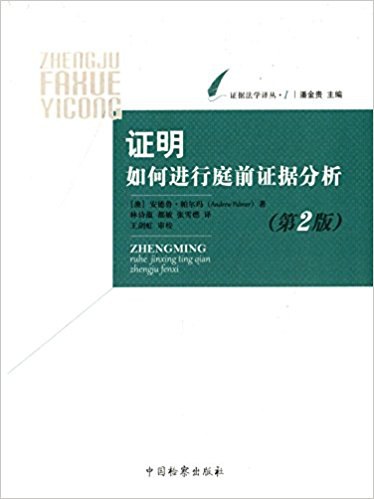
《证明 如何进行庭前证据分析》"庭前证据分析:凯利·伯顿书评"
1
0

长者 2023-09-18 01:14:53
Andrew Palmer, Proof: How to Analyse Evidence in Preparation for Trial (Lawbook Co, 2nd ed, 2010) 248 pp from https://lr.law.qut.edu.au/
Palmer developed the methods of analysing evidence in preparation for trial explored in this book based on his own practical experience as a barrister and as a teacher of evidence and proof units at the Melbourne Law School. He suggests that his work does not necessarily represent what a litigator should do in practice, or what a litigator does in practice, but rather reflects what a litigator might do in practice. This book does not contain extracts of cases or evidentiary rules, or a comprehensive digest of the rules of evidence. Instead, it focuses on the process of preparing for trial, for example, how to prepare a chronology of the evidence for the purpose of revealing inconsistencies in evidence, gaps in evidence, and weaknesses in a case.
Palmer has written this how-to guide from the perspective of a mentor, who offers advice to a less experienced colleague on how to prepare for trial. His writing style is user-friendly and fundamental evidentiary terms are emphasised in bold. There is a worthwhile summary at the end of each chapter to highlight significant points and the chapters commonly map out an example of the method in question in a flowchart to aid understanding.
This book is primarily aimed at students and teachers of advocacy and evidence, and inexperienced litigators, who seek a greater understanding of document management in practice, particularly how to marshal the sources of evidence, develop a case theory, and prove the theory by matching evidence and mapping arguments. While there are some references to the case law, the Evidence Act 1995 (Cth) and Victorian legislation, the book is generally not jurisdiction-specific and would be beneficial to advocacy and evidence students across the globe. This book should be on the recommended textbook list for all advocacy and evidence units, especially in the current climate where greater linkages are made between learning and practice, and preparing students for the real world is aspired.
Other audiences for this book include barristers, solicitors and police prosecutors who are planning to enhance their methods for preparing for trial. Further, the book is relevant to advocates in both criminal and civil law, irrespective of whether they are representing the Crown, accused person, plaintiff or defendant.
Chapter 1 provides an overview of the methods utilised in the book. It specifies that the methods can be used as isolated tools or be used in an integrated approach and not necessarily in the sequence outlined in the book. The methods followed depend on a litigators time, resources, preferences, as well as the needs of the case. One message that comes across first and foremost in chapter 1 is that preparation is the key to successful advocacy. This theme is commonly echoed in other tips on advocacy.
Chapter 2 reinforces the importance of document management in the trial process, particularly knowing what documents are available and where they are located. It suggests some means for categorising documents. There is no right or wrong way of organising documents and it depends on the types of proceedings and the litigators preference.
Chapter 3 recommends that a litigator prepare a chronological inventory of information based on events, procedures or investigations. The purpose of a chronology is to record inconsistencies in the evidence, identify weaknesses in a case, or help structure an interview with a witness or client. A chronology may be given to the courts as part of submissions or supporting material. Chronologies should contain the date, time, and description and be cross-referenced to the sources of evidence.
Investigative thinking is examined in chapter 4. It is defined as the identification of possible theories or hypotheses and the search for evidence that will support or eliminate those theories. The chapter emphasises three steps in investigative thinking:
- abduction: the imagining of a hypothesis or working theory of the case that provides an explanation of the evidence currently available to us; - retroduction: the identification of tests that might confirm or disprove the hypothesis; - investigation: the carrying out of the above tests through the application of appropriate investigative techniques.
Information should be marshalled according to the sources of evidence (for example, real evidence, documentary evidence, and testimony), scenarios, clues, legal rules or factual issues. The boundaries between the methods appear to be blurry. A prosecutor or plaintiff, who bear the onus of proof, should prioritise the legal rules approach because if there is no evidence for an element of an offence or action, there is no case to answer.
While evidence texts universally assert that a case theory needs to be developed, they do not explore the nuts and bolts of developing a case theory. Chapter 5 of this book fills this gap. A case theory refers to an event that has legal consequences, for example, an accused murdered the deceased. In this example, the criminal law (substantive law) breaks the case down into elements of the offence of murder (the facts in issue). A theory is the story (material facts) that satisfies the case. When developing a theory, the following issues should be considered: 1. Is the theory consistent with the clients instructions? 2. Does the theory fit within the elements of the substantive law? 3. Does the theory account for all of the evidence? 4. Is the theory supported by evidence? 5. Is the theory plausible in the sense it is consistent with common views and expectations? 6. Is the theory simple? 7. Are you offering alternative theories that undermine the main theory? 8. Can the theory be succinctly expressed with clarity? 9. Is the theory flexible enough to cope with changing circumstances, for example, a hostile witness or evidence that is ruled inadmissible? In addition to developing a case theory, advocates should anticipate their opponents case theory.
Chapter 6 continues with the theme of theory and specifically how to match direct and circumstantial evidence to the theory. Direct evidence requires a witness to give testimony of their actual observation whereas circumstantial evidence requires facts in issue to be inferred. Arguments may be based on direct or circumstantial evidence, and a litigator should be aware if the evidence combines in a corroborative, contradictory, conflicting, convergent or linked manner. The arguments to be made in a closing address can be mapped by the following three methods: prose (draft of closing address); chart (diagram); and outline (point form). Palmer outlines six common mistakes with charting at the end of the book.
Chapter 7 examines testimonial evidence, real evidence, and documentary evidence. With regard to testimonial evidence, it suggests an advocate may make arguments about bias, motive, previous convictions, expertise, opportunity, demeanor, and memory. The admissibility of real evidence hinges on authenticity and accuracy while documentary evidence centres of accuracy and contemporaneity. This chapter also focuses on circumstantial evidentiary issues such as requiring chains of inferences to link evidential evidence to the main facts in issue, making inferences based on generalizations, the standards on which links in chains and strands in cables need to be proved, and the best ways of handling alternative explanations. This chapter raises the concepts of negative evidence, for example, where an accused person exercises their right to silence, and missing evidence, for example, where an accused person destroys evidence.
The hearsay rule, opinion evidence, and similar fact evidence are canvassed in chapter 8 and the discussion is appropriate for those students who are struggling to understand these essential concepts. A more detailed exploration of these concepts can be found in the case law, legislation and other evidence texts on the market.
Chapter 9 reviews how to develop a trial book, which includes court documents, opening address, outline of key points to adduce from the witness, copies of statements made by a witness, copies of documents that are relevant to the credibility of witnesses, copies of documents that witnesses will be asked to authenticate, list of opponents likely witnesses, substantive law, outline of submissions to be made about the admissibility of evidence where there is likely to be a dispute, and draft closing address.
Teachers of evidence and advocacy will be drawn to the Notes section, which appears after chapter 9. This section outlines how evidence is taught and assessed at the Melbourne Law School. The students are provided with detailed briefs of evidence (approximately 100 pages) and they complete a case analysis (50% of their marks) and an admissibility analysis (50% of their marks). The assessment task is authentic and it better prepares students for the role of an advocate in the real world. Many examples of briefs of evidence and sample answers are readily available at www.evidence.com.au under the sample analyses link. The examples predominantly relate to Commonwealth drug offences and teachers who assess the Evidence Act 1995 (Cth) may aspire after them. This website sets a high benchmark for other evidence and advocacy teachers but will undoubtedly encourage teachers to reflect on their own assessment practices, and may in some cases even be a driving force for enhancing authenticity in this discipline.
The Notes section is followed by an appendix, which offers a sample analysis of evidence based on a decided case. Palmer utilises a decided case because it can be presented in the book in a mor
相关推荐
萤火谷的梦想家
艾莉森•麦吉出生于1960年,是美国《纽约时报》畅销书作家,同时也是大都会州立大学创意写作课的教授。她的作品被翻译成20多种语言并出版,也曾被提名普利策奖,并获得苏斯博士奖金奖、克里斯托弗图书奖、美国 [美]艾莉森•麦吉/[美]克里斯托弗•丹尼斯/绘 2023-03-27 16:50:25鬼马女神捕1·绝密卧底(上)
腹黑凤凰vs毒舌鸡妖——蓝翎:“小姬,跟我去人界吧!”姬十四:“干吗?让人宰了我做小鸡炖蘑菇吗?”蓝翎:“不啊,让妖怪宰了你做小鸡炖蘑菇更气派。”凤凰蓝翎和鸡妖姬十四生活在无忧无虑的灵界。他们的故乡叫 郝天晓 2023-04-17 00:22:47© 2023-2025 百科书库. All Rights Reserved.












发表评价